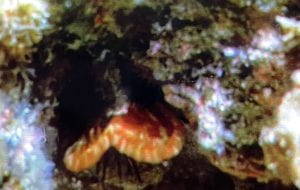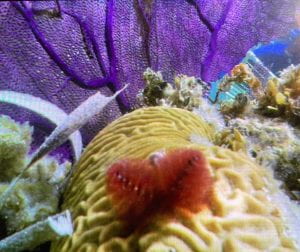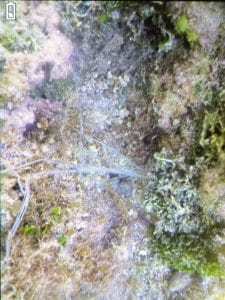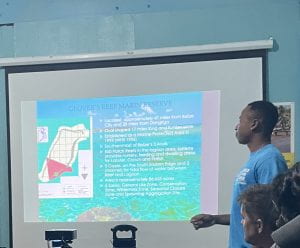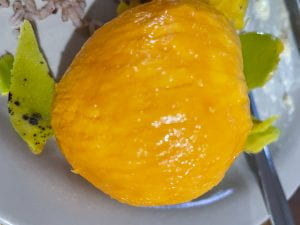In the morning, we traveled by boat to more marine protected areas to continue our coral health research project and conduct more sea urchin gathering/counting (I discovered that it is very fun to hold sea urchins and not scary at all :D). We also caught our second lionfish of the day! Yay!
I also noticed a beautiful and healthy branching fire coral (millepora alcicornis). It dawned on me that despite a few stag horn corals in the area that it was one of the only branching hard coral left healthy on this reef. I could see fish and sea urchins all around it! It’s so important to our coral reef ecosystem!
I also saw my first star horse-shoe worm (pomatostegus stellatus)! It was bright orange and very sensitive to my water movement, but I finally managed to get a picture! You can tell it’s a star horseshoe worm by it’s U-shaped crown radiole, but it’s hard to see in this picture.
Below is another cool Christmas tree worm!
Later when snorkeling just off of Glover’s Atoll for our optional snorkel, I saw a pufferfish (pictured below) and a stingray with my snorkel buddy Faith. I also spotted a lionfish and alerted the group, but unfortunately we could not catch this invasive species.
I also saw some a new species of worm called spaghetti worms (eupolymnia crassicornis)! They usually live in holes in the sand or in coral and they have long (< 18 inches) thin noodle-like tentacles which help them to catch food! I was surprised to see so many since they usually live on or under the sand which makes them hard to see. If you lightly touch their tentacles it will retract which is so cool to see. I love annelids.
Later that night, we had a guest lecture from the manager of Glover’s Research Station, Rafael. He told us that this was one of the only places in the Caribbean that is dedicated to preserving pristine reefs. There is not commercial fishing in this area, and fishermen willing to break this rule face these thousands of dollars in fines- some can even face jail time. If a large amount of fish that is illegally caught and dead, all the fish will eventually be donated to humanitarian nonprofits such as orphanages. There has only been 4 infractions in 2022 so far. Three people are stationed on Glover’s Atoll which include the manager, ranger, and marine biologist and these people enforce the laws. Since there is limited staff, some times the Coast Guard will also assist when there is trouble. The Glover’s Reef Staff has maintained good relations with the local fishermen and some of these fishermen will report illegal fishing that they see. Rafael told us he saw a shift of thinking towards sustainable fishing for the local people as although fishing is a necessity for providing for their families they also want to preserve their reefs. Glover’s Reef Research Station has assisted the Wild Life Conservation Society in many surveys such as: turtle egg surveys, lobster surveys, stony coral tissue loss disease surveys, and conch surveys.
It’s very cool to see these conservation efforts and I hope I can contribute in any small way! Peace and love from Belize.
~ Maegan
(this is such a beautifully cut mango that I felt needed to be highlighted :p)



